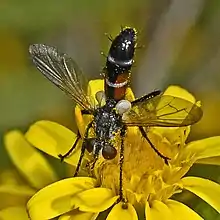Cylindromyia interrupta
Cylindromyia interrupta is a species of fly in the family Tachinidae.[4][5][6][7]
| Cylindromyia interrupta | |
|---|---|
 | |
| Cylindromyia interrupta | |
| Scientific classification | |
| Domain: | Eukaryota |
| Kingdom: | Animalia |
| Phylum: | Arthropoda |
| Class: | Insecta |
| Order: | Diptera |
| Family: | Tachinidae |
| Subfamily: | Phasiinae |
| Tribe: | Cylindromyiini |
| Genus: | Cylindromyia |
| Subgenus: | Neocyptera |
| Species: | C. interrupta |
| Binomial name | |
| Cylindromyia interrupta | |
| Synonyms | |
Distribution and habitat
This species is present in most of Europe, Russia and in North America ( Alaska to California, North Dakota, Colorado and New Jersey).[7] These tachinid flies live in hedge rows and dry meadows.[8]
Description
Cylindromyia interrupta can reach a length of 6–8 millimetres (0.24–0.31 in) and a wingspan of 12 millimetres (0.47 in).[8][9] Body is slender. Thorax is black, while the abdomen is reddish with two silver rings, a wide longitudinal black marking and black apical tergites. Hind tibiae have 1 or 2 posteroventral bristles. Apical scutellars are absent. The abdomen has median discal bristles on tergites 1, 2, 3 and 4.[10] The bright white calypteres stand out.[9]
Biology
Adults can be found from May to August. They mainly feed on nectar and pollen of Apiaceae (especially Leucanthemum vulgare).[8] This tachnid fly parasitizes moths and true bugs (Hemiptera). The larvae develop inside the living host.[9][11]
References
- Meigen, J. W. (1824). "Systematische Beschreibung der bekannten europaischen zweiflugeligen Insekten". Vierter Theil. Schulz-Wundermann, Hamm.: xii + 428 pp. Retrieved 9 May 2020.
- Walker, F. (1849). List of the specimens of dipterous insects in the collection of the British Museum. Part IV. London: British Museum. pp. [3] + 689–1172 + [2]. Retrieved 20 October 2022.
- Loew, H. (1844). "Zur Kenntnis der Ocyptera-Arten". Stettiner Entomologische Zeitung. 5: 226-240–266-269. Retrieved 22 August 2023.
- Chandler, Peter J. (1998). Checklists of Insects of the British Isles (New Series) Part 1: Diptera. Handbooks for the Identification of British Insects. Vol. 12. London: Royal Entomological Society of London. pp. 1–234. ISBN 0-901546-82-8.
- Belshaw, Robert (1993). "Tachinid Flies Diptera Tachinidae". Royal Entomological Society Handbooks. Royal Entomological Society of London. 10 (4ai): 170.
- van Emden, F.I. (1954). "Ditera Cyclorrhapha Calyptrata (I) Section (a) Tachinidae & Calliphoridae". Royal Entomological Society Handbooks. Royal Entomological Society of London. 10 (4a): 133.
- O’Hara, James E.; Henderson, Shannon J.; Wood, D. Monty (5 March 2020). "Preliminary Checklist of the Tachinidae (Diptera) of the World" (PDF). Tachinidae Resources. Retrieved 1 July 2023.
- Commanster
- John Sankey Insects in an Urban Garden - Diptera
- Key to the genus Cylindromyia - Tachinid Recording Scheme
- The Tachinid Times